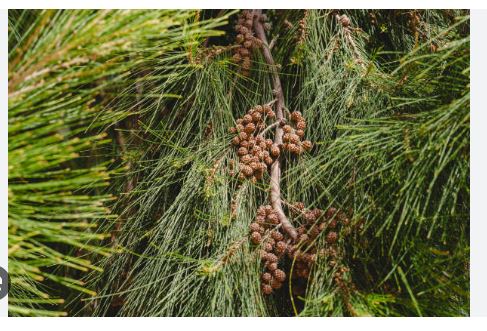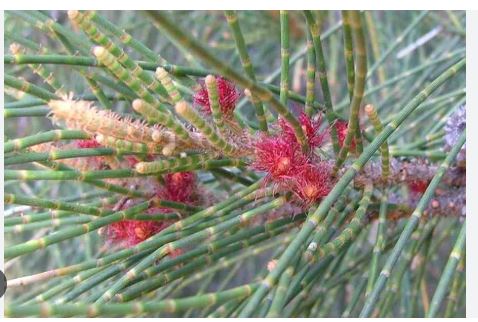
The Australian Pine, commonly known as She-oak (Casuarina equisetifolia), belongs to the family Casuarinaceae, which includes about 90 species across four genera. It is classified within the genus Casuarina, named for its resemblance to the cassowary bird’s feathers due to its needle-like branchlets. The species name equisetifolia derives from its horsetail-like foliage, resembling the genus Equisetum. Two subspecies are recognized: C. equisetifolia subsp. equisetifolia and C. equisetifolia subsp. incana, distinguished by branchlet and cone characteristics. Despite its common name, it is not a true pine but a flowering angiosperm, often misidentified due to its conifer-like appearance.
Casuarina equisetifolia is an evergreen, monoecious tree typically growing 20–115 feet tall, with a wispy, pine-like appearance. Its bark is smooth and greyish in youth, becoming scaly, greyish-brown to black with age. The foliage consists of slender, drooping, grey-green branchlets up to 12 inches long, with leaves reduced to tiny, scale-like teeth (0.3–0.5 mm) in whorls of 6–8. Male flowers form terminal spikes, while female flowers are small, axillary clusters. The fruit is a woody, cone-like structure (10–24 mm long) containing winged seeds (samaras). Its needle-like branchlets and small, spiny cones distinguish it from true pines.
Native to Australia, New Guinea, Southeast Asia, and India, the Australian Pine thrives in coastal regions, particularly behind beaches, near estuaries, and on rocky headlands. It prefers sandy, saline, or calcareous soils and tolerates high winds and salt spray, making it a pioneer species in disturbed coastal ecosystems. Introduced globally, it has naturalized in places like Florida, Hawaii, and the Caribbean but is highly invasive in southern Florida, where it outcompetes native vegetation. Its wind- and water-dispersed seeds facilitate rapid spread, contributing to its invasiveness.
Casuarina equisetifolia is hardy in USDA Zones 9–11, tolerating temperatures down to about 25°F (-4°C), though young trees may need protection from frost. It thrives in warm, frost-free climates with high heat and salt tolerance, ideal for coastal areas in southern Florida, California, and Hawaii. In cooler zones, it can be grown in containers and moved indoors during winter, but its rapid growth and invasiveness limit its suitability outside its hardiness range.
Historically, the Australian Pine was planted in Florida in the late 1800s for windbreaks, shade, and erosion control along canals and beaches due to its salt and drought tolerance. Its wood is used for fuel, poles, furniture, and marine pilings, though it’s prone to cracking. Indigenous Australians used its seeds and bark, and its nitrogen-fixing roots improve soil fertility. However, its invasiveness in Florida, where it displaces native plants and disrupts wildlife habitats, has led to its classification as a Category I invasive species, with cultivation now prohibited. Its dense shade and allelopathic effects harm ecosystems, making control efforts critical.

Cultivaion of Australian Pine (She-oak)
Select a Suitable Location
Choose a site with full sun, as Casuarina equisetifolia requires at least 6–8 hours of direct sunlight daily for optimal growth. Ensure the location accommodates its mature size, typically 20–115 feet tall and 20–40 feet wide, with space for its spreading canopy. Coastal areas with sandy or saline soils are ideal, but avoid planting near sensitive ecosystems or urban infrastructure due to its invasive roots and litter.
Use Well-Drained, Sandy Soil
Plant in well-drained, sandy, or loamy soil with a pH of 5.5–8.0, mimicking its coastal native habitat. It tolerates saline, calcareous, or poor soils but struggles in heavy clay or waterlogged conditions. Test soil drainage; water should drain within a few hours. Amend clay soils with sand or gravel to improve aeration and prevent root rot.
Plant in the Right Season
Plant in spring or early fall in warm climates to promote root establishment before extreme heat or cold. Dig a hole twice as wide and as deep as the root ball, positioning the root collar at ground level. Backfill with native soil, avoiding rich amendments, as the tree thrives in lean conditions. Water thoroughly and mulch lightly to retain moisture.
Water Moderately During Establishment
Water deeply every 7–10 days during the first 1–2 years, providing 1–2 inches of water to encourage deep roots, especially in dry periods. Use drip irrigation to target the root zone, avoiding trunk saturation. Once established, the tree is highly drought-tolerant and typically relies on rainfall, requiring supplemental water only during prolonged droughts.
Mulch with Inorganic Materials
Apply a 1–2-inch layer of inorganic mulch, such as gravel or crushed stone, around the base, extending to the drip line but keeping it 3–4 inches from the trunk to prevent rot. Inorganic mulch mimics coastal conditions, conserves moisture, and reduces weed competition without retaining excess water, which could harm the nitrogen-fixing roots.
Fertilize Minimally
As a nitrogen-fixing species, Casuarina equisetifolia requires little to no fertilization. In nutrient-poor soils, apply a low-nitrogen, slow-release fertilizer (e.g., 5-10-10) once in early spring during the first year to aid establishment. Avoid over-fertilizing, which promotes excessive growth and increases litter, exacerbating its invasive potential.
Prune for Structure and Safety
Prune lightly in late winter or early spring to remove dead, damaged, or crossing branches and to maintain a balanced canopy. Young trees benefit from structural pruning to establish a single trunk for stability in windy coastal areas. Avoid heavy pruning, as the tree’s wispy form is natural. Remove lower branches for clearance in urban settings, using clean, sharp tools.
Monitor for Pests
The tree is relatively pest-resistant but may attract scale insects, caterpillars, or bagworms in stressed conditions. Check for sticky residue, webbing, or foliage damage. Treat minor infestations with insecticidal soap or neem oil, ensuring good air circulation. Encourage natural predators like birds to control pests, and avoid planting in overly wet conditions that attract fungi or insects.
Prevent Fungal Diseases
Casuarina equisetifolia is susceptible to root rot or fungal wilt (e.g., from Fusarium or Ganoderma) in poorly drained soils. Ensure proper drainage and avoid overwatering. If branchlets yellow, wilt, or drop excessively, inspect roots for rot and improve soil conditions. Remove affected branches with sterilized tools and avoid replanting in contaminated soil.
Protect from Frost Damage
Hardy in Zones 9–11, the tree tolerates light frosts but may suffer damage below 25°F (-4°C), especially when young. In marginal zones or during rare freezes, cover young trees with frost cloth and mulch the root zone with gravel. In colder regions, grow in large containers and move indoors during winter, maintaining temperatures above 25°F.
Control Invasive Spread
The tree’s wind- and water-dispersed seeds can lead to uncontrolled spread, especially in coastal or disturbed areas. Regularly remove seed cones before they open to prevent self-seeding. Monitor nearby areas for seedlings and remove them promptly. In regions where it’s invasive (e.g., Florida), avoid planting and focus on removal to protect native ecosystems.
Propagate with Caution
Propagate via seeds or cuttings, though seeds are more common. Collect cones in late summer, extract winged seeds, and soak in warm water for 24 hours before planting in a sandy mix; germination takes 2–4 weeks. Semi-hardwood cuttings taken in summer with rooting hormone can root in 6–8 weeks but are less reliable. Limit propagation in areas prone to invasiveness.
Select Non-Invasive Alternatives
In regions where Casuarina equisetifolia is invasive, choose native or non-invasive alternatives like Black She-oak (Allocasuarina littoralis) for similar aesthetics without ecological harm. If planting, select nursery stock labeled for controlled growth and monitor spread. Pair with salt-tolerant plants like coastal banksia or bottlebrush to create a cohesive, low-maintenance landscape.
Additional Tips
- Staking: Stake young trees in windy coastal areas for the first 1–2 years to stabilize roots, using flexible ties and removing stakes once established to promote trunk strength.
- Litter Management: Expect needle-like branchlet and cone litter; avoid planting near pools or high-traffic areas to minimize cleanup.
- Ecological Caution: Its allelopathic effects and dense shade can suppress native plants. Use in controlled settings and consult local authorities (e.g., extension services in Australia or California) to ensure compliance with regulations.